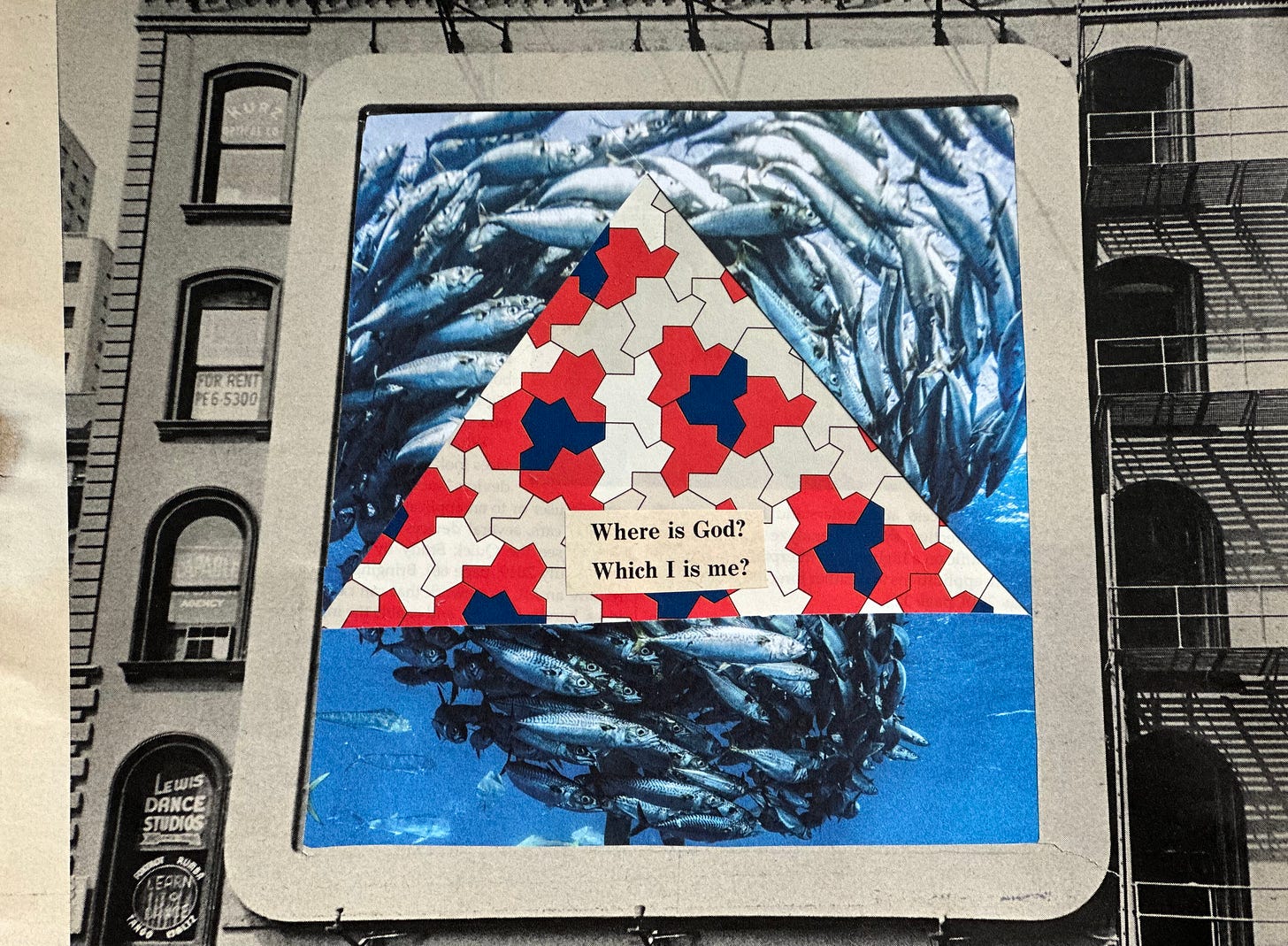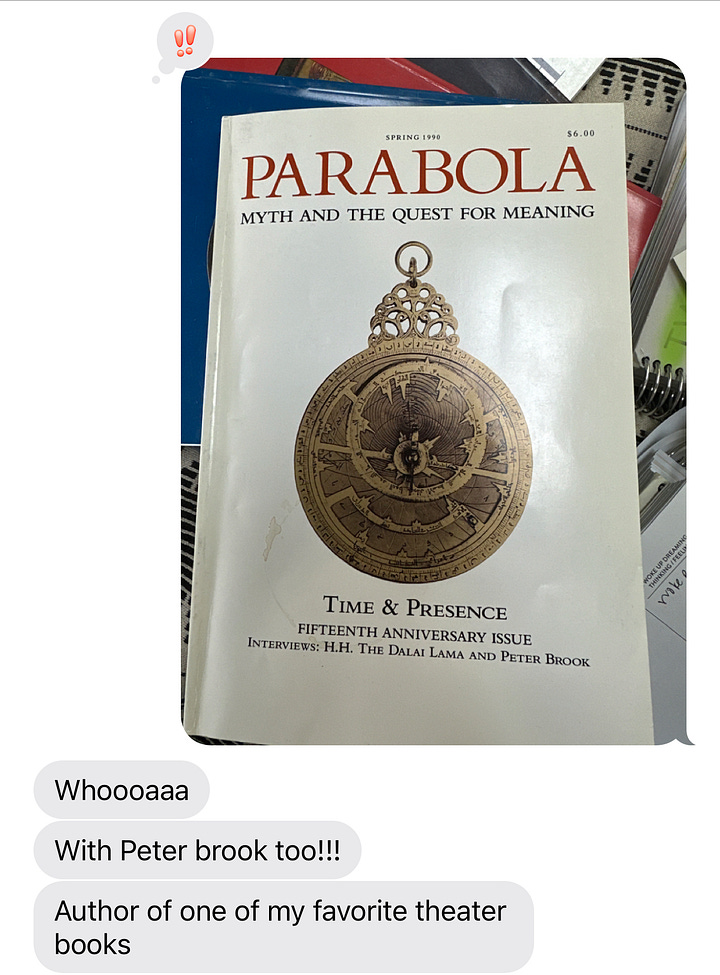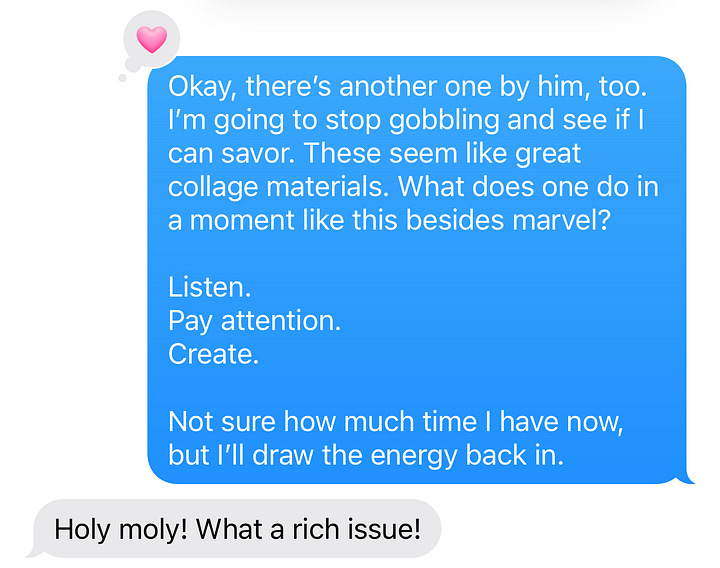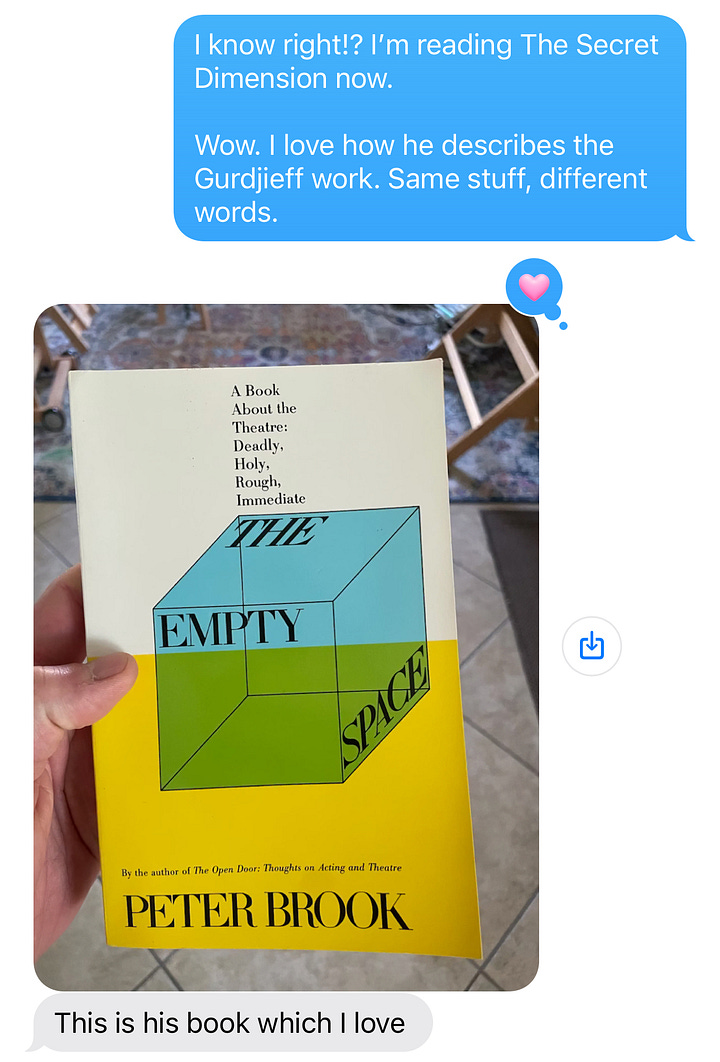A Surge of Coherence
But in actual fact, everything is happening in every moment. -Father Thomas Keating
On a morning outside of routines,
Out for coffee at a shop you do not choose,
there is a portal.
On a shelf in the back with the used books,
there is a stack of magazines
from the 1990’s.
The name Parabola is familiar.
After a dream that opens time,
God whispers words into
search results
for a heart
about to let go of
the truest thing it has ever known.
You pay $32.64 for eight issues.
Inside Time and Presence,
the teacher who leads a heart to
the truest thing it has ever known
talks with another teacher
about time, and the conversation
rings a bell.1
"A movement toward our own center
is really a movement toward
everybody’s center, which is the
oneness of the
ultimate
unifying
source
of all creation.
In other words, individuals are bound together by a
unifying force
which is present
but not normally perceived,
given the human condition,
without the discipline of
a practice
that
penetrates
the mystery of ordinary time.”
How does one hold
a surge of coherence like this?2
Voice memo a friend,
of course. Text a photo
of the cover, the table of
contents.3
It may call to them, too —
transmit the ineffable.
Don’t forget to take
a deep swig;
feel it flow all the way through;
but do not bite down.4
This is the safest place we know.
LISTEN
Bandcamp:
Spotify:
In her 2024 book Thomas Keating: The Making of a Modern Christian Mystic, Cynthia Bourgeault describes what led to the moment her coordinates converged with those of Father Thomas Keating. She writes:
The last thirty years are the part of the journey that I shared with Thomas. If I am particularly drawn to this phase of his emergence, it’s at least in part because I saw it unfolding before my eyes. To some small degree, I even participated in its midwifing.
Thomas and I did not always have an easy relationship. We challenged each other mightily — which, in the end, may have been our greatest gift to one another since there were very few people in either of our lives who did that for us. Over the three decades of our casually intertwining friendship, we chewed through a lot of shadow material, disappointed each other deeply at times, but worked our way through to a grudging respect and finally to a heartfelt love. Just as this book is not a biography of Thomas Keating, neither is it a personal memoir of my own journey with him. Yet I realize that this is one of those places where I need to fill in a bit of the backstory so that you have a better sense of how I’ve come to know what I know of him and of the perspective from which I’ll be making some of my observations later in this book.
The name Thomas Keating first appeared on my radar screen in the early 1980’s through Jacob Needleman’s now iconic book Lost Christianity. Searching for any signs of conscious life still flickering within what he took to be a mostly moribund institution, Needleman had gotten wind of experiments with “the centering prayer” underway at the time among some of the brethren at St. Joseph’s Abbey and had trooped out to Spencer to investigate. While less than fully impressed with the practice itself, he admired the mettle of these brethren, particularly their abbot, Thomas Keating, and called rightful attention to their efforts. I devoured his book and took quiet note.About five years later, Parabola Magazine asked if I could recommend a Christian spiritual master they might interview for their upcoming 25th [sic] anniversary edition. The unspoken subtext was a “Christian master who could hold his own” in the company of the Dalai Lama and a stellar cast of other spiritual luminaries they were including in this blockbuster edition. Recalling Needleman’s favorable mention, and my own initial impressions from having recently worked my way through Open Mind, Open Heart, I recommended Thomas Keating. Parabola accepted my recommendation and asked me to do the interview.
That’s how I came to be seated face-to-face with him that day — November 19, 1989—in the parlor at Chrysalis House, the contemplative lay community he had recently launched in Walden, New York. The interview went a little bit awkwardly, I thought, the two of us never quite getting on the same wavelength, but it all ended in a brilliant final moment when I expressed an interest in taking up the practice, and he invited me on the spot to a ten-day retreat at St. Benedict’s Monastery sometime the following year. I signed up for the May slot, and the rest is history.
The Spring 1990 Issue of Parabola Magazine featured that interview (!). He is still speaking to us. Here are some highlights:
Keating: Eternal time implies the values of eternity, which transcend ordinary time, breaking into linear time. Besides the three-dimensional world of time and space there is the source of it that is always present, too, as the chief aspect of every reality. And its values are totally encompassing and embrace all time as if in an eternal embrace. So all of eternity is present in each moment of time for the person or seeker who has interiorized those values.
Bourgeault: The moment itself takes place in chronological time?
Keating: Yes, chronological time keeps moving. Now in this context you could also conceive of it as circular time. Chronological time is a favorite view of the Western world; circular time, which is perhaps closer to the natural cycles is more in honor in the Eastern religions. But in either case — whether you conceive of it as circular or linear, going toward an end point — eternal time, since it transcends the space/time continuum, is present in every moment. And this is what makes every moment of ordinary time extraordinary.
Bourgeault: We don’t seem to feel it as extraordinary very often.
Keating: That’s because our perception of it is ordinary, meaning nothing is happening. But in actual fact, everything is happening in every moment —
Bourgeault: — if we could only wake up to it?
Keating: That’s what awakening really is. It’s awakening to the full value of each moment of time, as penetrated by eternal values. And along with eternity, of course, go all the intuitive and unitive values of oneness that are covered over by perception of categories and divisions on the mental-egoic, or rational, level — especially for traditions cut off from their contemplative traditions and roots.
At a deeper or higher, or what I prefer to call a more centered level, a movement toward our own center us really a movement toward everybody’s center, which is the oneness of the ultimate unifying source of all creation. In other words, individuals are bound together by a unifying force which is present but not normally perceived.
From Bourgeault’s Blog Post “Enstasy: Exploring Jean Gebser, Lesson 14” on the Wisdom Waypoints Blog
The term “ecstasy” comes from the Greek ec-stasis, “standing outside of oneself.” Its opposite is “ENSTASY,” a term I first encountered in Valentin Tomberg’s profound discussion of the subject in Meditations on the Tarot (pp. 309-311). It means centering in oneself: becoming fiercely, alertly coiled within one’s own “I Am” presence, such that one becomes a center of gravitation in one’s own right. (Incidentally, I believe that Teilhard is pointing toward this same quality when he speaks of centration.) Rather than seeking to transcend or outrun that core sense of personal selfhood in order to dissolve in the infinite, one instead hunkers down in that very self-center and within its finite lineaments encounters in concentrated form that same infinite plenitude of being. Rather than the drop dissolving in the ocean, the ocean fully instantiates in the drop.









What a score finding those magazines!! Thank you for sharing the excerpts. And my new favorite word and personal aim: Enstasy.